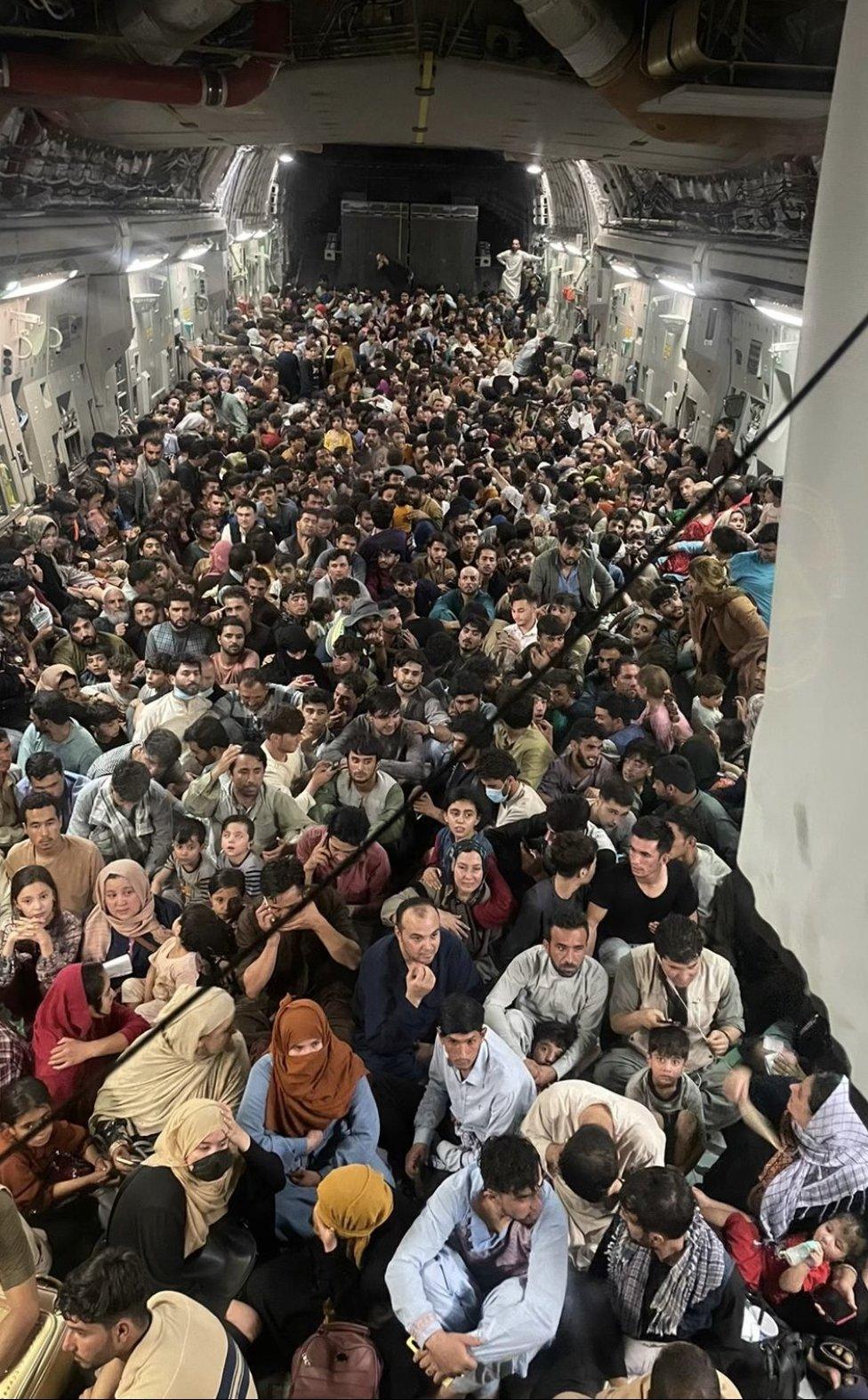Afghanistan: Striking image captures Kabul exodus
- Published
It's one of the most striking images from the takeover of Afghanistan by the Taliban. Hundreds of Afghans packed into a US military cargo plane as they flee Kabul.


The faces, many male but with some women and children, look up towards the camera, their expressions a mixture of anxiety and possibly some relief.
The image was initially obtained by the US defence analysis website, Defense One, but was released by the US Air Mobility Command public affairs office on Tuesday.
On Sunday, panicked civilians had scrambled up the loading ramp, Defense One quoted a US official as saying, but the crew decided it was best to take off rather than force the Afghans off the plane.
The number onboard - 640 - is among the highest carried by that type of plane, a C-17 Globemaster.
It's approaching, though still some way off, the record for the number of people transported by any plane - an Israeli Boeing 747 carrying more than 1,000 Jewish migrants from Ethiopia in 1991.
The US defence official quoted by Defense One, says the flight from Kabul to Qatar was one of several which managed to extract hundreds of Afghans from Kabul.
The photo stands in contrast to the chaotic images which emerged from Kabul airport on Monday as it was overrun by Afghans terrified at the prospect of Taliban rule. US soldiers struggled to keep control.
Chaotic scenes at Kabul airport as people try desperately to flee
An image of the same type of plane from Monday showed hundreds of Afghans running alongside the moving aircraft, some clinging to the side. Local media reports said at least two fell to their deaths once it took off.
Some have questioned why it is predominantly men seen at the airport.
One explanation is that many women have been staying indoors, fearing how they will be treated by the Taliban.
Another is that many families would want their men to leave first so they can help from outside Afghanistan, financially, and eventually find a way to bring their loved ones out of the country.
While the airlifts will be welcomed by many, the numbers could be a drop in the ocean of those who feel compelled to leave in fear of the Taliban.
The UN refugee agency, the UNHCR, has called on countries not to force the return of Afghans previously deemed not to need protection.
It estimates 550,000 Afghans have been internally displaced by the conflict since the beginning of the year.
Between 20,000 and 30,000 are thought to be fleeing across borders every week, the UNHCR's Afghanistan representative, Caroline Van Buren, told CNN. And government figures suggest 120,000 moved to Kabul as Taliban forces closed in.
Many of those in fear for their lives have worked with US-led forces, notably as translators or contractors. But the Taliban's treatment of women during its previous rule in the 1990s and its use of barbaric punishments is another major spur to leave.
At the beginning of August, the White House announced a plan to allow thousands of Afghans with links to the US to resettle there. On Monday, President Joe Biden announced $500m (£362m) in aid for Afghan refugees.
The US has relocated some 2,000 Afghans out of the country under its Special Immigrant Visa scheme, officials say, and plans to transport thousands more.
Other countries are helping out too, including Germany. Chancellor Angela Merkel told party leaders that Germany may need to evacuate some 10,000 people, including 2,500 support staff.
UK Foreign Secretary Dominic Raab told BBC Breakfast that 150 British nationals were flown out on Sunday.
Last week, the UK extracted 289 Afghans. Several hundred more will leave in the next 24 hours, he said.
But the turmoil in Afghanistan has raised fears in Europe of a new influx of migrants. A stark illustration is Turkey's decision to boost security at its lengthy border with Iran where Turkey is building a concrete wall.



Have you or a loved one been evacuated from Afghanistan? Please tell us your story by emailing haveyoursay@bbc.co.uk, external.
Please include a contact number if you are willing to speak to a BBC journalist. You can also get in touch in the following ways:
WhatsApp: +44 7756 165803
Tweet: @BBC_HaveYourSay, external
Please read our terms & conditions and privacy policy
If you are reading this page and can't see the form you will need to visit the mobile version of the BBC website to submit your question or comment or you can email us at HaveYourSay@bbc.co.uk, external. Please include your name, age and location with any submission.